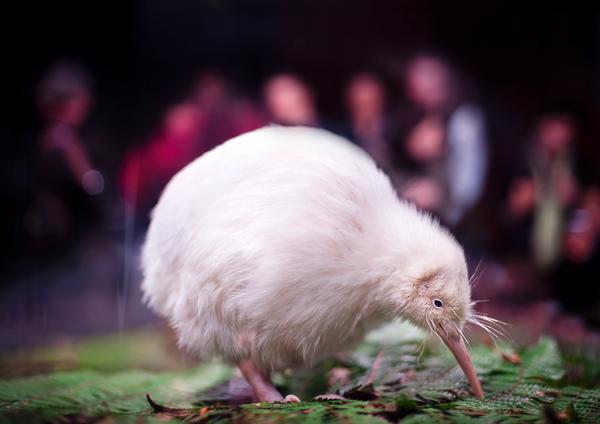Rare white kiwi moves into nocturnal house
Friday 11 November 2011, 7:23AM
By Pukaha Mount Bruce
444 views
Manukura, the rare white kiwi making global headlines since she hatched six months ago, today moved into the nocturnal kiwi house at her Pukaha Mount Bruce home where she will soon be able to be seen by the public daily.
The decision to retain Manukura in the safety of captivity is subject to her welfare and behaviour and has been influenced by strong public feedback and her potential vulnerability in the wild.
“Manukura continues to capture the hearts of people from around the world,” said Rangitane o Wairarapa chief executive and Pukaha Mount Bruce board member Jason Kerehi. “Her recent health scare when she swallowed two large stones emphasised the interest the public has for her care and wellbeing. We will continue to do our best to ensure she is properly cared for.”
“While the aim of Pukaha’s kiwi breeding programme is to establish a sustainable wild population in our forest, Manukura is widely seen as a special gift that should be fully protected, as long as she is content,” Jason Kerehi said.
“She has already become an advocate for the recovery of her endangered species and we hope that this will continue through her being easily visible to the public.”
Manukura returned to the national wildlife centre today, fully-recovered after swallowing two large stones and spending three weeks in the care of Wellington Zoo vets. The second and largest stone was successfully removed by a urologist in a ground-breaking laser procedure usually used to break up kidney stones in humans.
When transferred out of her travelling box into the nocturnal house enclosure, she quietly took in her new surroundings for a few minutes before being placed into her brooder box by Department of Conservation Captive Breeding Ranger Darren Page.
“The timing is right to try Manukura out in the kiwi house,” Pukaha Mount Bruce manager Kathy Houkamau said. “Her return home coincides with her almost reaching 1,200 grams - the weight at which juvenile kiwi are usually released into the wild. She has already been out of her familiar surroundings for a few weeks, we will have control over her environment and climate and we can observe her.”
“We are hopeful that her relatively laid back nature will help her to settle in quickly. However it can take up to six months for a kiwi to settle into a nocturnal house so we will be monitoring her closely.”
The nocturnal house creates a night time environment during the day so kiwi can be seen by visitors in an enclosure that simulates their natural habitat. “White feathers will really stand out in her darkened enclosure which will make her very easy to see,” Kathy Houkamau said.
Manukura’s change from day to night will be made gradually over 24 days with the lighting adjusted by an hour every other day to avoid the ‘jet lag’ effect of experiencing two consecutive daytimes. This means the lights in her enclosure will be on until late November during the day and she will be asleep.
Manukura will initially live alone, and once she has settled in a second kiwi may be introduced into her enclosure. A second enclosure in the nocturnal house is home to two other kiwi, Vincent and Tahi.
Since 2001 an intensive pest control programme in and around the 940-hectare Pukaha Mount Bruce native forest has been successful in re-establishing populations of kiwi, kokako and kaka.
ends
Background information – Manukura
· Hatched on 1 May at Pukaha Mount Bruce National Wildlife Centre, Manukura was the thirteenth of fourteen kiwi successfully hatched at Pukaha Mount Bruce in the 2010/11 breeding season.
· Manukura was hand-reared in Pukaha Mount Bruce’s new kiwi nursery alongside other kiwi chicks until she was one month old. She then moved to an outdoor enclosure and was raised in exactly the same way as all other chicks at Pukaha. The chicks are usually released into the wild when they reach sub-adult weight (approximately 1200g).
· Between July and mid-October 2011 visitors to Pukaha have had the rare opportunity to see Manukura at 2pm on Sundays.
· Named Manukura by local iwi Rangitane o Wairarapa, the kiwi is not an albino but the rare progeny of kiwi that were transferred to Pukaha from Hauturu/Little Barrier Island in May 2010.
· Manukura is believed to be the first all-white kiwi to be hatched in captivity.
· Rangitane o Wairarapa tribal elders saw the hatching of the white kiwi as a ‘tohu’ or ‘sign’ of new beginnings saying: “Every now and then something extraordinary comes along to remind you of how special life is.” They described Manukura as “a very special gift.”
· Meaning ‘of chiefly status’ the Maori name Manukura also joins the Rangitane people with Ngati Manuhiri, the tribe from Hauturu/Little Barrier Island which helped transfer 30 kiwi to Pukaha to boost the breeding programme there. ‘Kurahaupo’ was a Rangitane waka or canoe. ‘Manu’ means something of high rank and also a bird. Kura means ‘precious’ and also ‘feather’.
· Manukura made global headlines when she hatched in May and again last month when she swallowed two large stones and underwent ground-breaking surgery. Major newspapers, television networks and online sites around the world have told her story. Manukura’s Facebook page http://www.facebook.com/pages/Manukura-Little-White-Kiwi/218964361454747 follows her exploits and has a growing number of followers.
